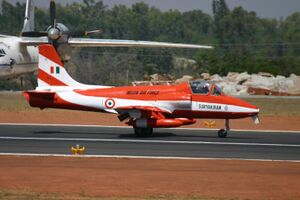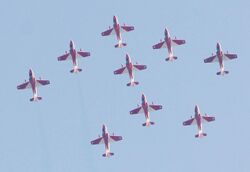Engineering:HAL HJT-16 Kiran
| HJT-16 Kiran | |
|---|---|

| |
| A HAL HJT-16 Kiran of the Indian Air Force | |
| Role | Intermediate jet trainer |
| National origin | India |
| Manufacturer | Hindustan Aeronautics Limited |
| First flight | 4 September 1964 |
| Introduction | 1968 |
| Status | In service |
| Primary users | Indian Air Force Indian Navy |
| Produced | 1964 -1989 |
| Number built | 190 |
| Developed into | HAL HJT-36 Sitara |
The HAL HJT-16 Kiran ("Ray of light") is an Indian two-seat intermediate jet-powered trainer aircraft designed and manufactured by aircraft company Hindustan Aeronautics Limited (HAL).
The Kiran was developed at the behest of the Indian Air Force (IAF), who sought a new intermediate trainer aircraft for its pilots. On 4 September 1964, the type performed its maiden flight; mass production commenced shortly thereafter. It has been adopted by the IAF, which uses the type to conduct intermediate training of pilots following on from basic trainers such as the HPT-32 Deepak and Pilatus PC-7. Furthermore, during the 1980s, the IAF procured a number of Kirans that were furnished with a more powerful engine and a higher number of hard points; the variant was designated Kiran Mk II. It has also been adopted by the Indian Naval Air Arm. The last Kiran was completed during 1989, after which the assembly line was shuttered.
The Kiran has been in operational use for over 50 years. Since the late 1990s, an indigenously designed successor, the HAL HJT-36 Sitara, has been in development, but has yet to enter service as of 2019. By the 2010s, use of the type was gradually declining as increasing numbers of newer BAE Systems Hawks, built under license by HAL, have been introduced to IAF service. The Kiran has been used by the Indian naval aerobatic team Sagar Pawan and was also used by the aerobatic team Surya Kiran of the IAF up until February 2011, at which point the team was disbanded after its aircraft were diverted to train fighter pilots. The Surya Kiran display team has been reequipped with specially-equipped Hawks. During December 2018, a handful of Kirans were donated by India to Myanmar.
Development
The Kiran was developed by Indian aircraft manufacturer Hindustan Aeronautics Limited (HAL) in response the issuing of an Indian Air Force (IAF) requirement that called for a new intermediate jet-powered trainer aircraft. HAL's design team devised a relatively conventional trainer; according to author Chris Smith, their design was closely modelled on the BAC Jet Provost, an existing United Kingdom jet trainer.[1] HAL chose to adopt the British-sourced Rolls-Royce Viper 11 turbojet engine, capable of generating up to 2,500 lbf (11,000 N) of thrust, to serve as its powerplant.[2] According to Smith, the development of what would become Kiran proved beneficial to other HAL projects, the design team being later redeployed to the HF-24 Marut, an indigenously designed fighter-bomber.[1]
On 4 September 1964, a prototype performed the type's maiden flight.[2] The initial production aircraft was designated Kiran I; during March 1968, the first deliveries of the pre-production aircraft were made to the IAF. Proving satisfactory, full-scale production of the type was approved shortly thereafter. Later production aircraft were fitted with hard points underneath each wing, which were intended for weapon training purposes; this modification led to such aircraft being redesignated as Kiran IA. A total of 190 Mk I and 1A aircraft were manufactured.[2]
During the 1970s, work was undertaken by HAL on an uprated version of the aircraft; it was instead powered by the Bristol Siddeley Orpheus turbojet engine, capable of generating a maximum thrust of 4,200 lbf (19,000 N). This variant, which was also furnished with an enhanced weapon-carrying capability, was designated Kiran Mk II. On 30 July 1976, this variant performed its first flight.[3] Around this time, India was seeking a more advanced trainer aircraft in response to difficulties experienced with trainee pilots transitioning from the original Kiran to frontline fighter aircraft.[4] Deliveries of the improved model commenced during 1985; production of the Kiran was terminated during 1989.[5]
Operational history
Since the initial aircraft first being delivered in 1968, the Kiran has been operated by both the IAF and the Indian Navy for the intermediate elements of their training syllabuses. Since the late 1990s, HAL has been working on developing a successor to the Kiran, which has been designated HJT-36 Sitara.[6] Its development has been protracted, being troubled by accidents during the test flight phase and having to perform an extensive redesign.[7][8] Another jet trainer, the British-designed BAE Systems Hawk, has been license-manufactured by HAL to supplement and gradually replace the IAF's aging Kiran fleet since 2007.[9] While deliveries of the Hawk and development of the Sitara continues, the operating life of the Kiran has been extended through to 2019, over 50 years after the first examples being delivered to the IAF.[10][11]
Following the grounding of the HAL HPT-32 Deepak fleet in 2009 amid safety concerns, the Kiran was temporarily used to perform both Stage I & II of fighter pilot training; this change was accompanied by considerable disruption, including a reduction of available flying hours to students as well as necessitating the redistribution of aircraft from the Surya Kiran display team.[12][13] During 2010, an urgent request for proposals was issued, seeking a rapid replacement for the HPT-32 and to enable the Kiran fleet to resume normal operations; the Pilatus PC-7 was subsequently selected for this role.[14][15]
Both the Indian Naval Air Arm and the Indian Air Force have independently operated their own aerobatic display teams, Sagar Pawan and Surya Kiran respectively.[16] On 3 March 2010, a Kiran Mk II of the Sagar Pawan aerobatic team crashed into a building in Hyderabad during the Indian Aviation 2010 air show, killing both crewmembers and injuring four civilians on the ground.[17] During the 2010s, the Indian Defence Ministry placed an order for 20 Hawk Mk132 aircraft with HAL to replace the remaining Kirans assigned to the Surya Kiran display team.[18][19] By 2019, several Hawks had been issued to the Surya Kiran display team and had been used to perform its trademark aerial displays.[20]
During December 2018, India donated six Kirans to neighbouring Myanmar, these aircraft were dispatched along with a team of specialists to train both pilots and ground crew in their operation.[21] Publication Times Now has speculated that this gift was an intentional politically-charged decision, intended to strengthen military ties between the two countries as well as to a means to counterbalancing the growing influence of China over the region.[22]
Variants
- Kiran Mk I
- Two-seat intermediate jet trainer powered by a Rolls-Royce Viper turbo-jet engine. 118 built.[23][24]
- Kiran Mk IA
- Two-seat intermediate jet trainer with armament capability. Two underwing hardpoints fitted. 72 built.[23][24]
- Kiran Mk II
- Improved version with four hardpoints and integral twin 7.62 mm machine guns in nose and a Bristol Siddeley Orpheus engine.[3] 61 built.[5]
Operators
 India
India
- Indian Air Force : 87[25]
- Indian Navy: 20[25]
 Myanmar
Myanmar
Specification (Kiran IA)
Data from Jane's All The World's Aircraft 1982–83[23]
General characteristics
- Crew: 2
- Length: 10.60 m (34 ft 9 in)
- Wingspan: 10.70 m (35 ft 1 in)
- Height: 3.64 m (11 ft 11 in)
- Wing area: 19.00 m2 (204.5 sq ft)
- Aspect ratio: 6.03:1
- Airfoil: NACA 23015 at root, NACA 23012 at tip
- Empty weight: 2,560 kg (5,644 lb)
- Max takeoff weight: 4,235 kg (9,337 lb)
- Fuel capacity: 1,137 L (300 US gal; 250 imp gal) internal fuel
- Powerplant: 1 × Rolls-Royce Viper 11 turbojet, 11.12 kN (2,500 lbf) thrust
Performance
- Maximum speed: 695 km/h (432 mph, 375 kn) at sea level
- Cruise speed: 324 km/h (201 mph, 175 kn)
- Stall speed: 137–145 km/h (85–90 mph, 74–78 kn) flaps extended and landing gear deployed
- Endurance: 1 hr 45 min
- Service ceiling: 9,150 m (30,020 ft)
- Time to altitude: 20 min to 9,150 m (30,000 ft)
Armament
- two 500lb (227kg) bombs or two SNEB rocket pods containing seven 68 mm rockets or two pods with 7.62 mm machine guns, or two 50-Imp Gal (226 litre) drop tanks
See also
Aircraft of comparable role, configuration and era
References
Citations
- ↑ 1.0 1.1 Smith 1994, p. 157.
- ↑ 2.0 2.1 2.2 Taylor 1982, p. 92.
- ↑ 3.0 3.1 Taylor 1988, p. 98.
- ↑ Smith 1994, p. 165.
- ↑ 5.0 5.1 Donald and Lake 1996, p. 201.
- ↑ "Indian air force Kirans to fly on, as IJT wait continues." Flight International, 14 February 2014.
- ↑ Shukla, Ajai (19 April 2019). "HAL's Intermediate Jet Trainer flies again after extensive re-design". Business Standard. https://www.business-standard.com/article/current-affairs/hal-s-intermediate-jet-trainer-flies-again-after-extensive-re-design-119041900219_1.html.
- ↑ Kumar Jha, Manish. "Is It Time For HAL To Buckle Up?." Business World, 26 December 2018.
- ↑ "Dubai 2007: First Indian Hawks delivered." Flight International, 12 November 2007.
- ↑ "Prolonging Surya Kiran's life..." Deccan Herald, 21 February 2015.
- ↑ Matthew, Neelam. "HAL Edged Out In Trainer Competitions." AIN Online, 3 April 2014.
- ↑ "May day: India’s New Basic & Intermediate Flight Trainers." Defense Industry Daily, 2 May 2019.
- ↑ Bahadur, Manmohan. "Airing out a decision." The Hindu, 7 December 2016.
- ↑ Francis, Leithen. "India to order primary trainers to replace HPT-32s." Flight International, 5 March 2010.
- ↑ Waldron, Greg. "India starts first training course with new PC-7 Mk II fleet." Flight International, 15 July 2013.
- ↑ "Surya kirans, IAF's Aerobatics team whose death defying manouevers leave audience spellbound." News Nation, 8 October 2017.
- ↑ "India Navy plane crashes at air show, killing pilots." BBC News, 3 March 2010.
- ↑ Hoyle, Craig. "Discussions continue for third Indian Hawk deal, says BAE." Flight International, 2 August 2013.
- ↑ "For Surya Kiran aerobatics team, IAF set to purchase 20 Hawks". The Indian Express. 26 October 2015. http://indianexpress.com/article/india/india-news-india/for-surya-kiran-aerobatics-team-iaf-set-to-purchase-20-hawks/.
- ↑ Kumar, Chethan. "Two Surya Kiran aircraft crash during practice at Aero India in Bengaluru, one pilot dead." Times of India, 20 February 2019.
- ↑ "Arms and Military Equipment Suppliers to the Tatmadaw." United Nations , August 2019.
- ↑ 22.0 22.1 "To counter Chinese clout, India to gift 6 HAL Kiran jet trainers to Myanmar". www.timesnownews.com. 1 December 2018. https://www.timesnownews.com/india/article/china-hal-kiran-myanmar-indian-air-force-southeast-asia-kaladan-multimodal-project-act-east-policy-narendra-modi-national-socialist-council-of/324243.
- ↑ 23.0 23.1 23.2 Taylor 1982, pp. 92–93
- ↑ 24.0 24.1 Donald and Lake 1996, p. 200.
- ↑ 25.0 25.1 "Pilatus PC-7 gives boost to IAF Academy". The Hindu. 13 December 2013. http://www.thehindu.com/news/cities/Hyderabad/pilatus-pc7-gives-boost-to-iaf-academy/article5452530.ece.
Bibliography
- The Illustrated Encyclopedia of Aircraft (Part Work 1982–1985). Orbis Publishing.
- Donald, David; Jon Lake (1996). Encyclopedia of World Military Aircraft (Single volume ed.). London: Aerospace Publishing. ISBN 1-874023-95-6.
- Smith, Chris. India's Ad Hoc Arsenal: Direction Or Drift in Defence Policy? Oxford University Press, 1994. ISBN:0-1982-9168-X.
- Taylor, John W. R. (1982). Jane's All The World's Aircraft 1982–83. London: Jane's Yearbooks. ISBN 0-7106-0748-2.
- Taylor, John W. R. (1988). Jane's All The World's Aircraft 1988–89. Coulsdon, UK: Jane's Defence Data. ISBN 0-7106-0867-5.
External links
 |




